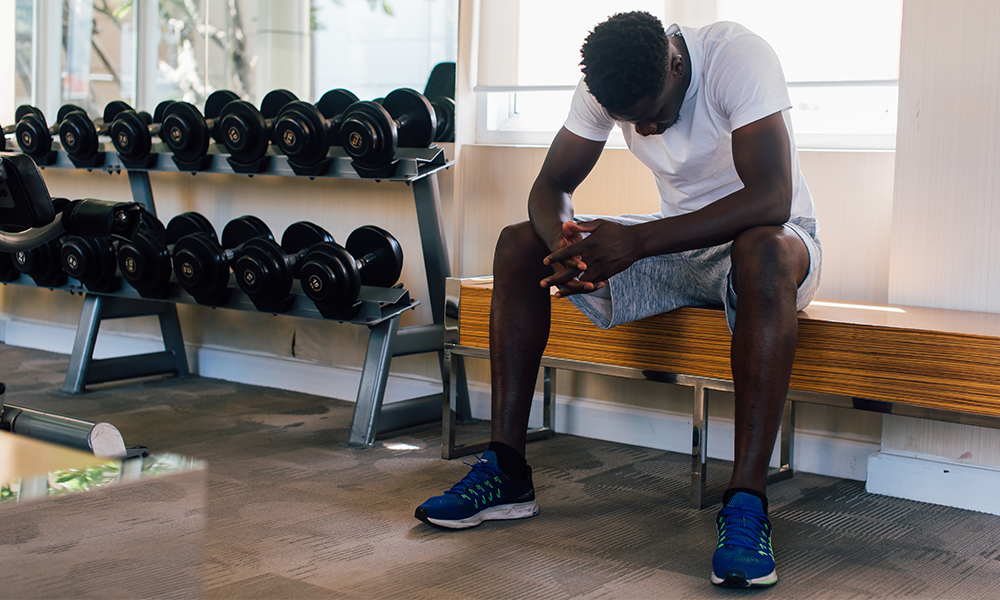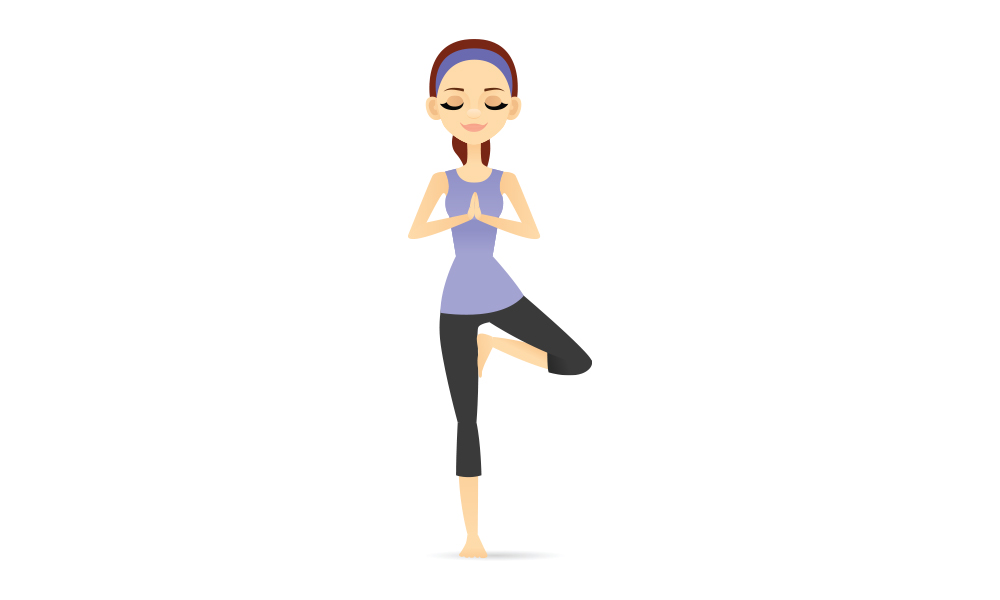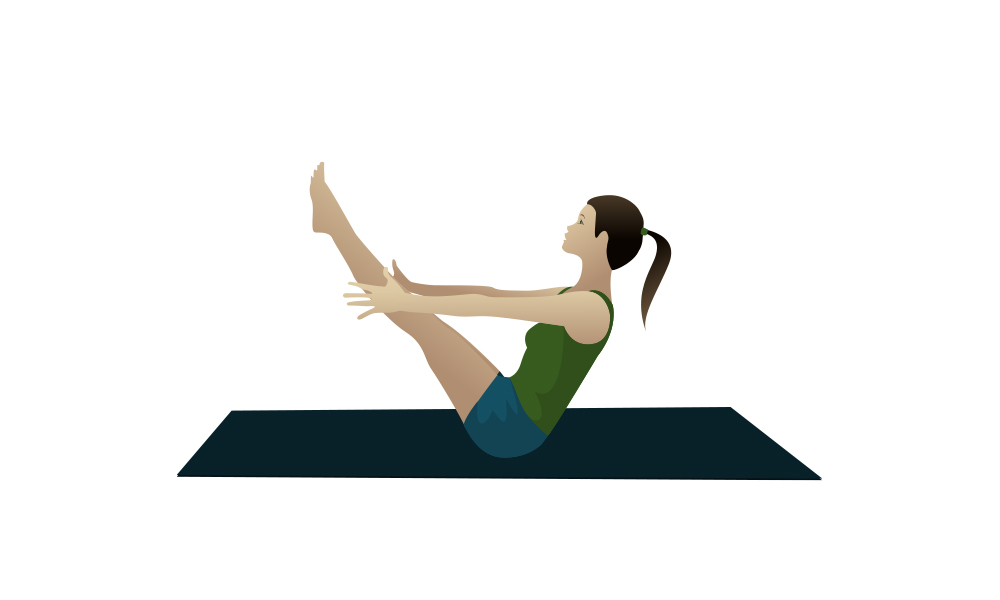With Halloween just around the corner, and fear taking center stage this time of the year, it’s about time you deal with yours too! However, it’s easier said than done, as you already know. But worry not. We’re here with 13 yoga poses to overcome your fear.
However, we suggest you take a holistic look at the subject to understand better why and how you can resort to yoga to overcome your fears.
Table of Contents
- What is Fear?
- What are the Functions of Fear?
- When Does Fear Become a Problem?
- How to Manage Fear So That It Becomes Something Positive?
- What is Yoga, and How It Helps You Overcome Fear and Anxiety?
- Yoga Helps You Focus on the Present Moment
- Yoga Helps Improve Your Breathing
- Yoga Helps Improve Your Sleep
- It Helps You Get Away From Stress-inducing Thoughts
- 13 Yoga Poses That Will Help You Overcome Fear This Halloween
- Conclusion
What is Fear?

Fear is one of humanity’s most deeply rooted emotions. But it is crucial to understand that fear fulfills a primary function in human beings: survival. This makes it a fundamental emotion to avoid dangers and keep us safe.
Nonetheless, you must realize it is an autonomous, intuitive and unconscious response. A response that can block you or even become anchored in your life, becoming a phobia and/or causing panic or anxiety attacks.
What Are the Functions of Fear?
As stated earlier, the primary function of fear is survival. So, this emotion is nothing more than an adaptive mechanism to an environment that can give you a reason to fear it.
Fear is related to your ability to react to dangerous situations since it is the emotion that makes you withdraw when there is a threat. It can be a threat to your life, your safety (what you consider safe), or your self-esteem.
Thus, fear reacts according to your mental patterns and beliefs. And it is that fear in itself is not bad. It helps you get away from situations you are not yet prepared for.
When Does Fear Become a Problem?

Remember, feeling fear in itself is not bad. The feeling is always positive. It means that you are alive and that you have emotions. The problem with feeling fear is when that fear paralyzes you, blocks you, and causes you to commit actions whose consequences can be worse than what caused that fear.
For example, you can’t focus on your training right because of the aura created around this famed guy. Despite knowing that you have everything it takes to stand up to him, you’re unable to put up with the pressure surrounding the whole thing. Do you see everything you’re missing?
The problem is not being afraid. The problem is how you handle and what you do with the fear you feel.
Fear is such a fundamental emotion that it would be impossible to live without it. And it is that your happiness and well-being depend on the decisions you make throughout your life.
You are responsible for being well and living a wholesome life. It helps you measure your steps and decide which way to go or how fast.
How to Manage Fear So That It Becomes Something Positive?
When you feel fear, your body reacts by causing an increase in your heart rate, sweating, and a drop in body temperature. Your pupils dilate, and your muscles stiffen.
All this leads you to an important question. Can you manage your fear in a way that affects your life positively rather than negatively? Well, the honest answer is yes, you can.
Yoga is one way to manage your fears, realigning them to influence your life positively.
What is Yoga, and How It Helps You Overcome Fear and Anxiety?

Yoga is a discipline that aims to train the functioning of the mind and ultimately create a higher level of calm, focus, enlightenment, and spiritual awareness.
Formally, yoga usually involves sitting or lying still and focusing the mind on the breath or a specific thought or visualization. Each yoga session lasts a particular time.
Below are some benefits and reasons why you may count on yoga to relieve stress and anxiety.
1. Yoga Helps You Focus on the Present Moment
Focusing on the present is something inherent to yoga as a discipline. In fact, it is the ever-present goal of all meditation. Do not hook yourself on the past or the future, but instead, persist in your present-moment focus. After all, it’s the only moment you really own.
Many refer to this as mindfulness or mindfulness practice. Naturally, this helps yoga to relieve anxiety. Because much of it stems from stress about the past or your concerns about the future.
For example, you might get stuck over an argument you had with your spouse last morning, or you might be worried about a work presentation you have later.
We all know worrying never changes anything. Therefore, realign your focus on the moment you have at your disposal currently (the present). It will help you eliminate those worries, leaving you less stressed and anxious.
2. Yoga Helps Improve Your Breathing
Yoga practice helps incorporate deep breathing as a primary trait. Steady, deep breathing is a feature of almost all forms of meditation. It’s part of why so many people worldwide resort to yoga poses for stress and anxiety relief, depression, and numerous other mental disorders. However, believe it or not, most people do not breathe properly.
From taking short, shallow breaths to “shoulder breathing” (not using the bottom of the lungs to inhale air), most of us tend to make the same “breathing mistakes” we’ve made for years without even realizing it.
The good news is that you can start practicing “better breathing” anytime, and yoga is a great way to make it easier. That is why yoga for panic attacks is a typical recommendation for people who panic often.
3. Yoga Helps Improve Your Sleep
Whether you are aware of it or not, anxiety affects your sleep. It’s like anxiety breeds a bad dream, which breeds more anxiety, which breeds a bad dream… and so on, a vicious cycle.
Everyone should aim to improve their sleep habits as it is recognized as an escape route for a host of physical ailments and mental stressors.
Fortunately, yoga has proven to be of great significance in improving sleep patterns. The specific ways it helps improve sleep range from the practice’s ability to calm restless and worrying thoughts to its influence on deep breathing, an essential element in enhancing nap time.
4. It Helps You Get Away From Stress-inducing Thoughts
Anxiety is caused as much by “phantom worries” as by real, practical life events. These include things like thinking someone has given you a wrong look when they probably haven’t or contemplating whether or not something farfetched in the future is going to work out.
But real-life concerns are also real. For example, thoughts about the results of a pending medical exam you are waiting for.
Fortunately, mindfulness meditation (focusing on the present moment) has been proven to help reduce anxiety-provoking thoughts, even real ones.
Related: How Marathon Training Can Help You Fight Anxiety
13 Yoga Poses That Will Help You Overcome Fear This Halloween
Now, it’s about time you get to the actual yoga poses that will help you overcome your fear, this Halloween or any other!
1. Butterfly Pose

Perfect for the start of a session, it warms your legs and improves your flexibility. It strengthens and relaxes the lower back, hips, groin muscles, thighs, and inner knee area. It improves blood circulation and stimulates the heart. Finally, it helps reduce anxiety and fatigue.
How to Do the Butterfly Pose?
- Sit down and bend your legs, bringing the soles of your feet together.
- Let your knees drop to their respective sides.
- Approach your heels towards your pelvis, keeping the outer part of your feet on the ground. And, if you can, hold your feet with your hands.
- Then, with your hands placed together in front of you, flutter your legs, knees up and down, as if your legs were wings. Your back stays straight.
2. Mountain Pose

Mountain pose or Tadasana reflects strength. The mountains rise majestically to the sky and sink deep into the ground. This position will help you achieve balance. The kind of balance while having your feet on the ground and your head in the clouds. Standing up and above your fears!
In addition, the mountains are strong and powerful, as well as the muscles of your legs, if you practice this position correctly.
How to Do the Mountain Pose?
- Stand up, your back straight and stretched like a golden thread connecting you to the sky at one end and the Earth at the other.
- Keep your feet parallel and open your chest.
- Raise your toes to feel your stability and repeat these few words: “I am strong and stable.”
- Bring your hands in front of your chest, palm to palm, then raise your arms above your head.
- Finally, lower your hands and say out loud or in your head: “I am a majestic mountain. I’m strong and mighty like a mountain.”
3. Candle Pose

It is an inverted posture: the head is lower than the body. This posture stretches the spine and strengthens the abdominals. It lends you a pleasant, relaxing effect, unwinding and unstressing you.
How to Do the Candle Pose?
- Lie on your back with your feet together and your arms along your body.
- Keeping your head and neck on your yoga mat, inhale as you raise both legs to 90 degrees. Make sure to use a thick, comfortable yoga mat, so your neck remains safe and unhurt.
- Lifting your hips toward the ceiling, place your hands on your hips and bring them up toward your shoulder blades.
- Raise your hips as high as possible, bringing your chest towards your chin.
- Keep your back supported by your hands, and make sure your feet are straight above your head.
- Breathe slowly in this position and focus on the throat area.
4. Warrior Pose

The warrior pose has a special meaning in terms of yoga. In this position, you become a warrior of peace, power, strength, and pacifism. It gives strength and courage!
This yoga pose strengthens your legs, improves your concentration, your balance, and allows you to acquire determination and self-confidence.
It is also used to stimulate the quadriceps muscles.
How to Do the Warrior Pose?
- Start with Tadasana or mountain pose. Bring your left leg back as you take a big step.
- Bend your right knee and place your hands on that knee. Your quadriceps remain contracted, and you keep a straight back. The toes of your front (right) leg should be facing forward, while the foot of the back (left) leg should be to the side, forming a right angle. You can repeat this mantra: “I am strong and focused.”
- Bend your right knee even more and raise your arms in a cross, repeating to yourself: “I am a warrior of peace.”
- Bend your right knee and turn your head to look at your right hand
- Repeat these steps with the other leg.
5. The Tree Pose

Another classic pose that is very helpful in overcoming your fear and anxiety is the tree pose or Vrkasana. Perfect for learning to maintain balance, reflecting the same traits in your personality, and helping you feel strong and wholesome.
How to Do the Tree Pose?
- Begin in mountain pose, standing.
- Bring the right foot’s sole to the left leg’s inside and support it on the thigh or calf while repeating this mantra: “I am focused and stable.”
- Stretch your arms upwards, imagining they are branches: I touch the sky.”
- Join your hands above your head, extend your arms, and repeat: “I am a strong and majestic tree.”
- Repeat all with the other leg.
6. Downward Facing Dog Pose

The downward dog posture, or adho mukha svanasana, is one of the most practiced yoga poses to eliminate fear and anxiety. This position is complete, as it stretches the whole body while strengthening the arms and legs.
How to Do the Downward Facing Dog Pose?
- Start with a 4-legged posture.
- Press your toes into the mat or floor and first lift your buttocks back upwards while exhaling
- Stretch your legs. Your back stays straight, your gaze towards your navel, and your head hidden between your arms. Try to place your heels on the ground, but without forcing it. That’s not the point. Your arms stay strong and push the ground.
- You can practice one or more full breaths in this pose.
7. Camel Pose

The camel pose or ultrasana helps you work the body’s flexibility and stretch the front part, incorporating appropriate posture.
It helps you feel as mighty, strong, and helpful as the camel.
How to Do the Camel Pose?
- Kneel with your knees hip-distance apart and your thighs perpendicular to the floor. Firmly press the shins and tops of your feet against the floor.
- Place your hands on your heels. Lean back as much as possible to stretch the entire front part of your body. Your gaze must lift to the sky while doing so.
- Release your arms and place your hands on your heels, chest out and head back. If your hands don’t reach your feet, keep your arms relaxed, avoiding overexertion.
- Hold the posture for a few seconds, then slowly return and put your buttocks on your heels. Steady yourself in this pose for a few breaths.
8. Cobra Pose

Also known as bhujangasana, the cobra pose can be practiced only by individuals who do not have back problems. It stretches your abdominals and relaxes the lower back, strengthening the arms and wrists. It also helps open up your chest wall.
Cobras are long, majestic, and stealthy. Feeling like a cobra during the exercise allows you to acquire the strength and confidence to overcome your fears.
How to Do the Cobra Pose?
- Lie flat on your stomach, resting your head on your hands while you think or repeat: “I am strong and mighty.”
- Place your hands under your shoulders and gently lift your head.
- Stretch your legs well behind your body, press down on the floor with your hands, and lift your chest, arching slightly backward.
- Lift and open your chest wide until your arms are almost fully stretched. You can repeat to yourself: “I am a cobra. I am strong.”
9. The Triangle Pose

Triangle pose or utthita trikonasana is a standing pose that helps stretch your leg and back muscles. Moreover, it helps open your chest to receive all the good that life should give you and send all the love you carry in your heart to the world. This instills peace and contentment in you.
How to Do the Triangle Pose?
- Spread your legs with your feet parallel while you say to yourself: “My legs form a right triangle.”
- Turn your right foot outward, and the left inward. Raise your arms crosswise and stretch them well out to the sides.
- Tilt your body to the right.
- Lower your right hand to the right ankle and repeat: “I am complete and balanced like a triangle.”
- Switch your feet and repeat everything.
10. Dragon Pose

The dragon, a playful posture, a shot of self-confidence!
Dragons are extraordinary creatures, powerful and always alert. The dragon pose is an excellent yoga pose to overcome fear and anxiety within you, in addition to stretching and strengthening your legs and arms.
How to Do the Dragon Pose?
- Get on your knees and straighten your back. Think or say out loud: “I am a mighty dragon.”
- Place the right foot in front of you, aligning it vertically below the knee.
- Stretch forward and down, letting your hips drop to the floor. Raise your arms to the sky.
- Exhale with a powerful utterance: “I spit fire through my mouth, Roahhhhhh.”
- Repeat these steps with the other leg.
11. Arrow Pose

The arrow pose or vasisthasana allows working balance, attention, and strength within you. It enables you to gain the power to build your abs, arms, and legs, helping you feel overpowering your fears and anxiety.
How to Do the Arrow Pose?
- Start in a kneeling position.
- Extend your left leg to the left side. Place your right hand under your right shoulder and extend your left arm upward. You can repeat to yourself: “I am rigid and tall as an arrow.”
- Press down on the floor with your hand and stretch your right leg, placing your right foot under your left.
- Lift your hips.
12. Boat Pose

The Boat Pose or Navasana works wonders in improving your strength and balance, ensuring you override your fear and anxiety.
How to Do the Boat Pose?
- Sit on the floor, hugging your knees.
- Place your arms behind you; your toes are extended forward. Lean back slightly.
- Lift your legs and stretch them forward. Your body becomes a ship that floats on the water.
- Extend your arms forward and maintain your balance. Breathe several times in the posture and repeat: “I am floating on the water like a boat.”
13. The River Pose

The river pose is a variation of paschimottansana. Water, even imaginary, has a natural soothing effect on the mind. This yoga posture allows you to work not only on your flexibility but also helps channel out your negative emotions, replacing them with peace and tranquility. You become gently flowing rivers.
How to Do the River Pose?
- Sit on the floor with your legs extended and your back straight.
- Press your hands on the floor and stretch your back well, breathing gently.
- Bring your hands to your feet and grab your toes. Bend the knees if necessary. You can repeat to yourself: “I am a river. I am a stream, calm, smooth, flowing, and strong.”
- Try to rest your chest on your thighs, bending your knees more if necessary. Breathe several times in this position. Try to stretch your legs a little more each time you exhale.
- In this posture, you can imagine that a stream of water runs through your body and absorbs the negative emotions that bother you, such as hatred, anger, sadness, disappointment, frustration, anxiety etc.
Related: Yoga Poses To Avoid Post-Workout Fatigue
Conclusion
Feeling fear is inevitable, but you must not let it take over you. Accept its existence, become aware of all this, and begin to take control of your life. Being aware of the present moment, being able to discard recurring thoughts, and silencing our inner voice when it is not behaving well with us is all that make us free and happy.
Again, what best time to tackle and overcome your fears than Halloween? So, RDX wishes you all the best for celebrating Halloween and winning over your fears.





